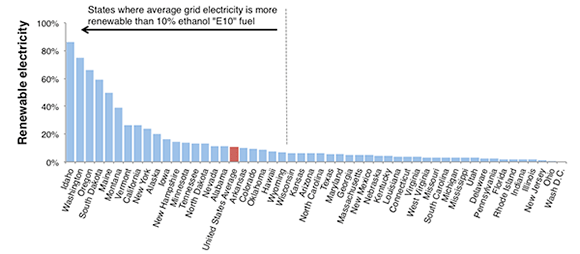Blog
Let's update US fuel policy to promote electric vehicles
The US Renewable Fuel Standard (RFS 2) has proven itself to be ahead of its time, so to speak. The planned trajectory away from corn ethanol toward non-food-based fuels—i.e., cellulosic biofuels, aka advanced biofuels, aka second-generation biofuels—is not becoming a reality. Of course, it’s difficult to predict when an entire new industry will achieve commercial-scale production, and so, unsurprisingly, the original Congress-mandated cellulosic biofuel requirements have had to be revised. Other RFS2 targets and provisions similarly need to be revisited as we accumulate knowledge and experience. The current review of the RFS by the House Energy and Commerce Committee could be a useful exercise along these lines. The committee is scheduled to hear diverse ideas on possible adjustments to the regulation on July 23rd and 24th.
One area where the RFS appears to be a bit behind the times, though, is on its very limited promotion of the electrification of the fleet. When the RFS2 mandates were established by Congress, biofuels were hot, but electric vehicles were not. Now, though, for the first time we have competitive plug-in electric vehicle designs by nearly every major global automaker – including models like the Roadster, Leaf, i-MiEV, 500e, iQ, Focus, Coda, fortwo, S, Fit, RAV4, Volt, C-Max, Fusion, Prius, Accord, and Karma. These vehicles are now pushing the efficiency frontier to above 100 mpg-equivalent when powered by electrons instead of petroleum fuels. Although these electric-drive vehicles are only about 1% of new sales today, electric vehicles will continue to enter the fleet, as electric vehicle technologies (batteries, motors, power electronics) improve, and costs are reduced with greater volume. The California Zero Emission Vehicle regulation will ensure that the volumes steadily become more substantial, to about 15% of new sales by 2025.
The great news about electric-drive vehicles (whether plug-in electric or hydrogen fuel cell), is that they can more easily draw from a mix of renewable and other lower-carbon energy sources (like natural gas and nuclear). When you plug in your electric vehicle, the chances are that some fraction of the electricity will come from a hydroelectric, wind, solar, geothermal, biomass or other renewable source. For context, the RFS has made most of our gasoline fuel in the US about 10% ethanol by volume, meaning it is about 7% ethanol by energy content. We can already beat this renewable content in many cases with electricity. Renewable electricity made up 12% of all US grid generation in 2012. You would beat the E10 renewable energy content by using the electric grid in 23 US states, and, going further, if you plugged in in some states (ID, WA, OR, SD, ME, MT, VT, CA, and NY) you’d be over 20% renewable on average based on EPA’s eGRID. So electricity may be a quicker way to getting more renewably-sourced fuel than relying on the RFS to squeeze more biofuels into the fuel at your local gas station.
Percent of electricity generation that is from renewable energy (hydro, wind, solar, etc) in 2010, by state. [Click to enlarge.]
Unfortunately, however, the current RFS2 regulatory structure does not readily allow utility providers to get credit for renewable electricity for electric vehicles. In contrast, California’s Low Carbon Fuel Standard does, and the European Fuel Quality Directive does too. Giving utilities credit for electric vehicles’ renewable energy use would help the utilities do their part in alleviating some of the plug-in issues on the infrastructure side.
We’ve submitted comments to the Energy and Commerce committee aimed at revising the RFS to better accommodate electric vehicles. The full document is here. The summary version of what we’d like to see:
- Adopt use of commercial transmission-supplied electricity
- Allow utilities to opt in to generate RIN credits based on their average overall commercial renewable electricity generation fraction
- Define renewable electricity to include wind, solar, hydroelectric, geothermal, in addition to biomass-fired and biomass co-fired power (already included in the standard)
- Utilize a standard electric vehicle efficiency conversion of about 3.0 for electricity-powered transportation sources to reflect how an electric vehicle delivers about three times more miles traveled per energy unit than a comparable conventional gasoline vehicle
Electric-drive vehicles will almost surely be a major part of any long-term climate stabilization scenario for the transportation sector, and it will probably take actions by many stakeholders and include supportive vehicle policies over a sustained transition period. So let’s update our fuels policies to help promote our electric-drive future.

